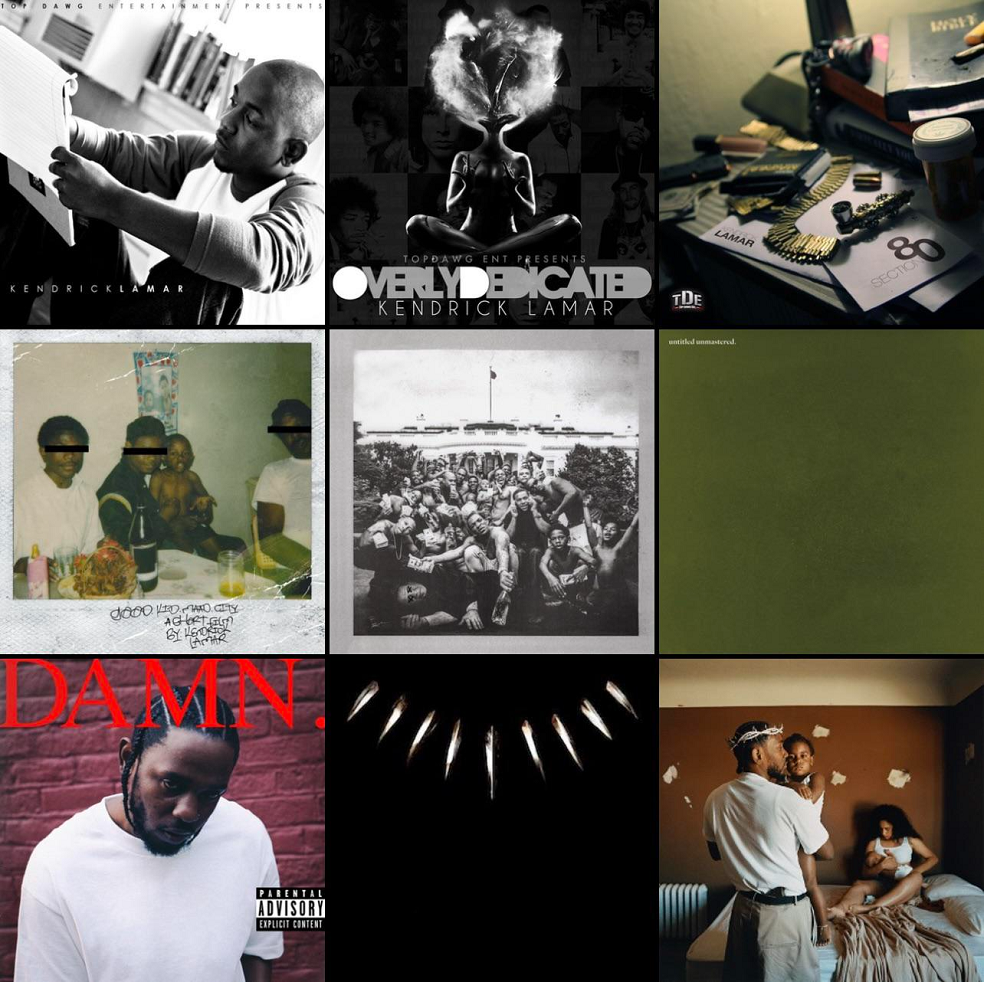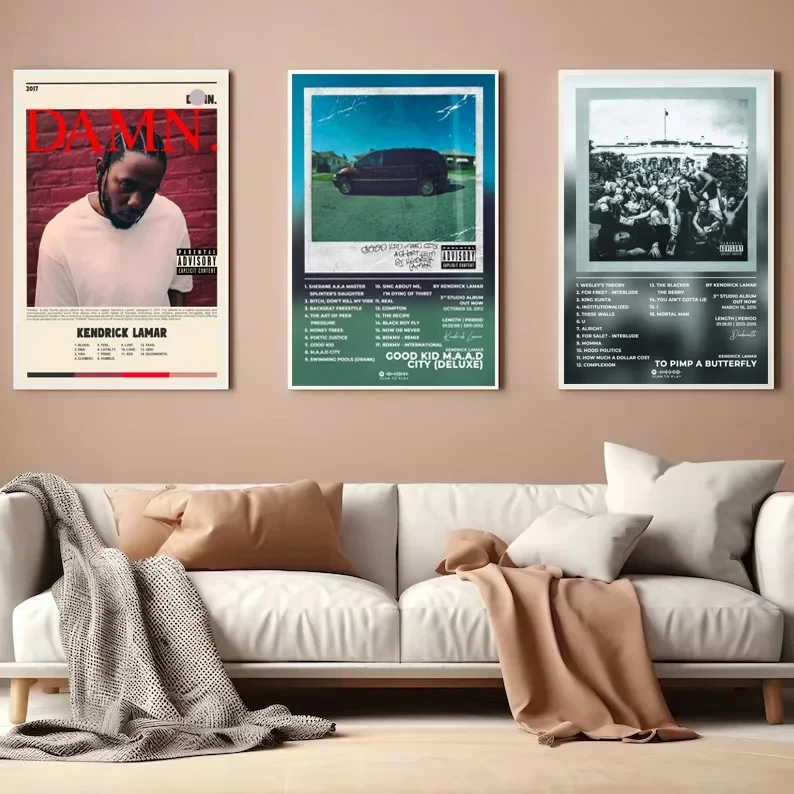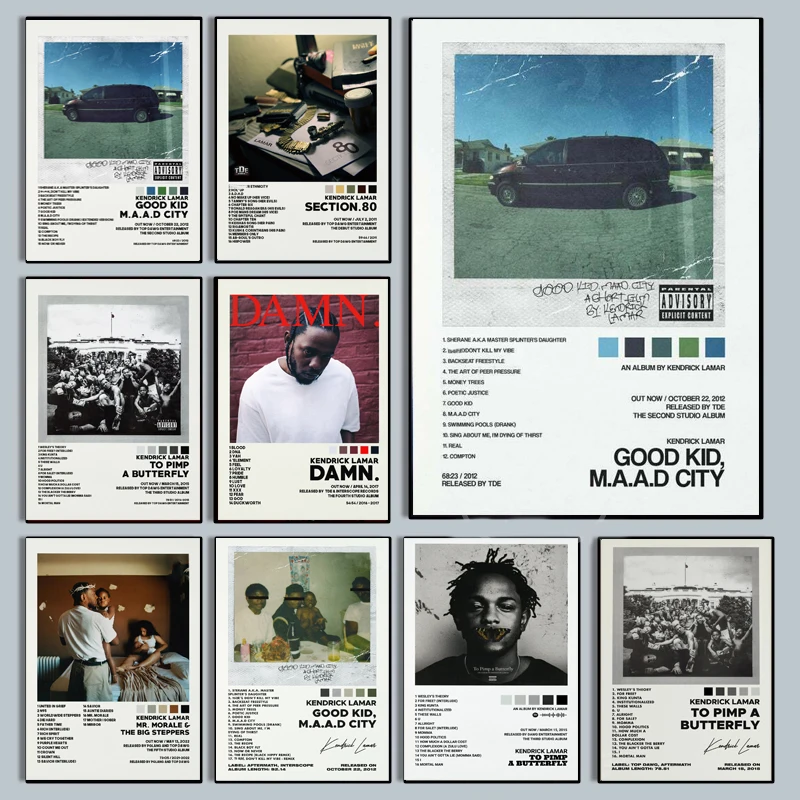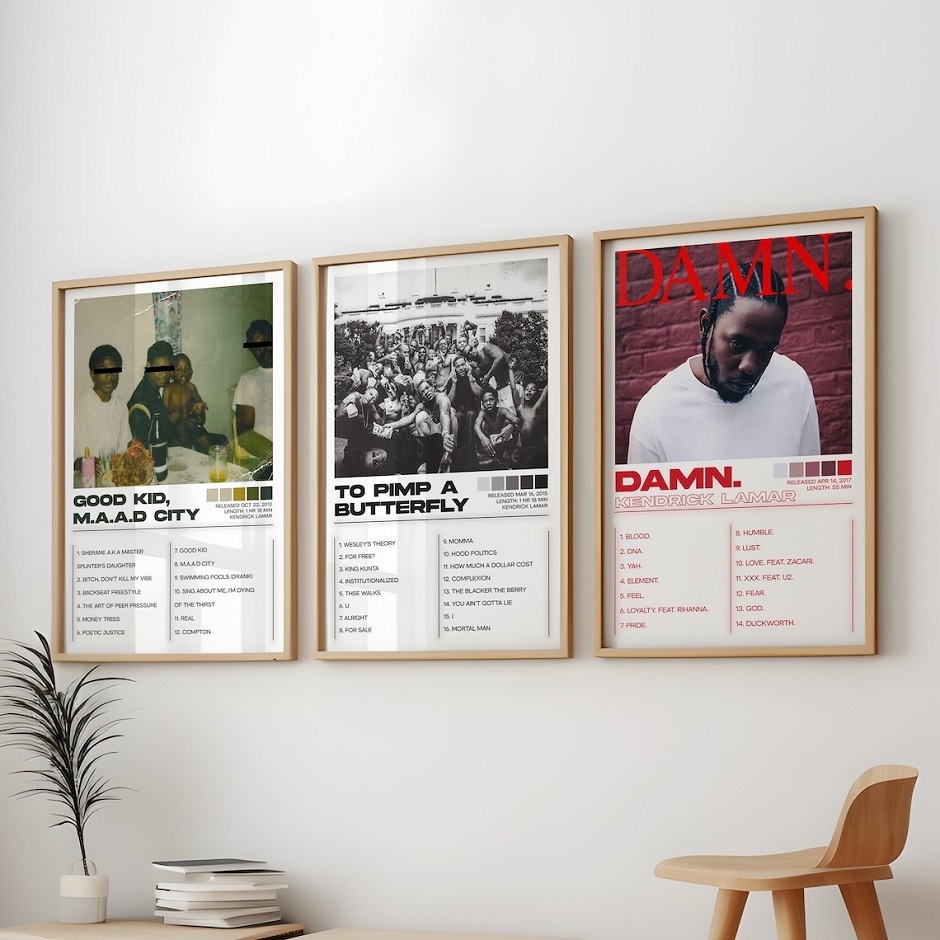Introduction
Kendrick Lamar is a name many recognize in Hip-Hop. His music has gained critical acclaim, and his lyrics often address societal issues. However, his album covers also deserve attention. Each cover reflects his artistic vision and amplifies the themes of his music. Let’s explore the significance of Kendrick Lamar’s album covers, how they connect with his songs, and their broader cultural implications.
The Power Behind the Visuals
Connecting Art and Music
Kendrick Lamar’s album covers are more than just images. They are integral to understanding his music. Each cover sets a mood and establishes a context for the themes explored in the album. For example, his cover for “To Pimp a Butterfly” features a striking image of Kendrick surrounded by a group of African American men. This image speaks volumes about unity, struggle, and cultural identity. The colors and expressions draw the viewer into the complex narrative that unfolds throughout the album.
The connection between the visuals and the music is vital. Kendrick’s covers often come alive with social commentary and powerful imagery. They evoke emotion even before you press play. For instance, the cover art for “DAMN.” uses a stark, minimalist style that aligns with the album’s introspective themes. The simplicity of Kendrick’s pose against a bold background illustrates the internal conflicts he faces, making the visual representation equally engaging as the sound.
Symbolism and Interpretation
Kendrick Lamar’s choice of visual elements is intentional. Each album cover is rich with symbolism that invites interpretation. For “good kid, m.A.A.d city,” the artwork shows Kendrick as a young man in Compton. The setting is gritty and real, mirroring the stories he shares in his lyrics. The cover draws you into his world and portrays the struggles of growing up in a challenging environment. The visual storytelling parallels the music, which is filled with vivid narratives.

Furthermore, the colors used in the album art hold significance. Bright hues can convey energy or hope while darker tones may signal struggle or despair. Kendrick skillfully utilizes these elements throughout his work. For instance, the contrasting colors in “To Pimp a Butterfly” reflect the complex emotions tied to themes of racism and resilience. The visuals serve as a guide to understanding the stories behind each track, allowing listeners to engage on multiple levels.
The Role of Culture in Kendrick’s Covers
Reflecting Societal Issues
Kendrick Lamar’s album covers do not shy away from critical social issues. They serve as platforms for discussing race, crime, and personal identity. His artwork often reflects the cultural realities faced by many in America. For “To Pimp a Butterfly,” the cover art acts as a powerful statement on African American identity. It visually represents a call for unity and strength in the face of adversity.
Kendrick’s ability to intertwine his art with societal themes is powerful. The imagery resonates with listeners who may experience similar struggles. For instance, the cover of “DAMN.” exists not only as an artistic expression but also as an invitation to reflect on personal dilemmas. The raw expression in Kendrick’s gaze captures the complexity of his experiences, thus connecting him to his audience.
Bridging Generations
Kendrick Lamar bridges the gap between generations through his art. His album covers often reference historical and cultural moments. For instance, on “To Pimp a Butterfly,” Kendrick’s visuals draw comparisons to the Civil Rights Movement. This connection extends the relevance of his work, prompting listeners to reflect on the past and its impact on present struggles.
By embedding such rich historical references in his art, Kendrick encourages dialogue across different age groups. Younger listeners might discover the narratives of their predecessors, while older generations may find resonance in Kendrick’s modern interpretations. This generational bridge enriches the overall experience of his music and solidifies his role as an influential figure in contemporary culture.
The Artistic Collaborations
Working with Visionaries
Kendrick Lamar collaborates with brilliant artists and designers to create his album covers. These partnerships lead to innovative and visually stunning representations of his music. For instance, with “To Pimp a Butterfly,” he enlisted the talents of renowned artist Kamasi Washington. Washington’s unique vision helped shape the cover into a manifestation of Kendrick’s message about racial identity and empowerment.
Collaborations extend beyond mere aesthetics. They enrich the storytelling aspect of Kendrick’s albums. By working with passionate creatives, he ensures that the visual art complements the lyrical themes. The synergy between music and art transforms the listener’s experience, creating a multifaceted journey through sound and imagery.
The Importance of Artistic Freedom
Artistic freedom plays a crucial role in Kendrick’s album covers. He often explores themes that challenge societal norms and conventions. This openness allows for authentic expression that resonates on various levels. Kendrick’s willingness to tackle difficult subjects is also reflected in his choice of cover art. Each piece may provoke conversation and encourage listeners to confront uncomfortable truths.
Moreover, his artistic decisions can empower others. By presenting challenging narratives through compelling visual art, Kendrick inspires young artists to explore their identities. He promotes self-expression and transparency, proving that art and music can serve as vehicles for change.
The Evolution Over Time
Growth and Transformation
Kendrick Lamar’s album covers showcase his growth as an artist. Over time, they reflect his evolving understanding of himself and the world around him. For instance, his debut album, “Section.80,” has a straightforward design that hints at a budding artist searching for his voice. As he matured, so did the complexity of his album covers. His later works reveal a deepening engagement with crucial topics, both personal and societal.
This evolution mirrors Kendrick’s musical journey. As he develops new ideas, his visuals adapt to represent these changes. The covers encapsulate his growth while still connecting back to his roots. This ongoing transformation creates a unique narrative thread that runs through each album, making them feel like chapters in a larger story.
Time Capsules of Emotion
Kendrick’s album covers also serve as time capsules. They capture the emotion and atmosphere of the period when they were created. For instance, “DAMN.” embodies the tension and uncertainty present in modern society. The stark visuals echo themes of conflict and introspection, reflecting the contemporary cultural landscape. Each album cover serves as a snapshot of its time, inviting listeners to delve into the societal climate and Kendrick’s personal struggles.
In this way, Kendrick’s art transcends individual albums. It invites listeners to look back at the context in which his music was created. His covers become portals to understanding broader cultural shifts and personal journeys, enhancing the overall impact of his work.
The Lasting Impact of Kendrick’s Covers
Cultural Significance
The influence of Kendrick Lamar’s album covers extends beyond the music industry. They have become cultural landmarks, serving as references in discussions about art, music, and identity. This significance highlights the power of visual storytelling in the world of Hip-Hop. Kendrick’s unique fusion of art and music challenges artists across genres to consider the visuals accompanying their work.
Fans often engage in discussions surrounding the meanings behind his covers. These dialogues further solidify Kendrick’s role as a cultural commentator. His ability to spark conversation around identity, race, and society is a testament to the profound impact of his visual art.
Inspiring Future Artists
Kendrick Lamar inspires a generation of artists to push boundaries within their own work. His approach to album covers encourages creatives to explore their identities and share their narratives. The originality and depth present in his visuals spark innovation among peers. Emerging artists recognize the value of pairing compelling art with their music, which can enhance the overall storytelling experience.
Many artists now pay closer attention to the design of their album covers. They understand that visuals can deepen listener engagement and provoke thought. Kendrick’s commitment to merging music and art ensures that the conversation around album covers evolves as the industry changes.
Conclusion: More Than Just Covers
In conclusion, Kendrick Lamar’s album covers are more than mere images on a disc. They are powerful portals into his world, reflecting his musical journey and societal commentary. Each cover art piece integrates deeply with his music, creating a rich tapestry of visuals and sound. As fans and observers, we are invited to engage with these works on multiple levels.
His covers foster dialogue, provoke thought, and inspire change. They highlight the importance of artistic expression while encouraging future artists to explore their stories. Kendrick Lamar’s contributions extend beyond music, reminding us of the significance of visuals in today’s cultural landscape. Each album cover stands as a testament to his vision, creativity, and impact on the world.




